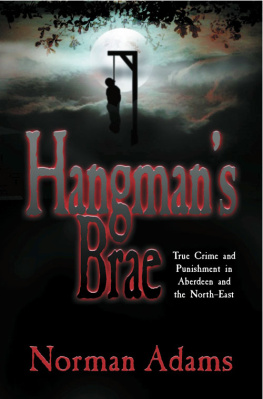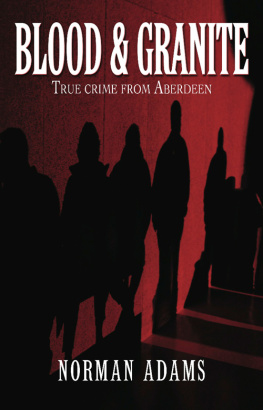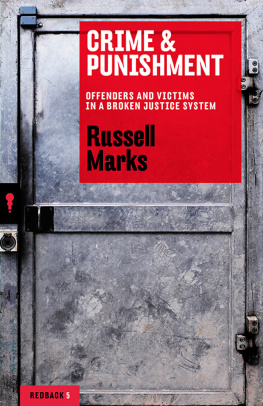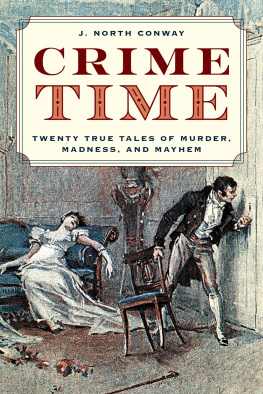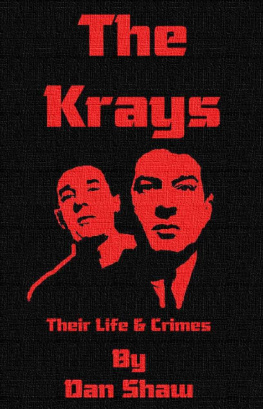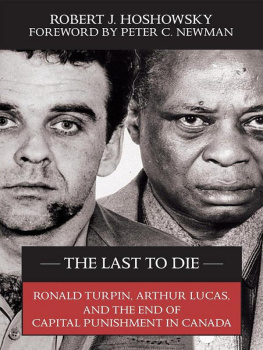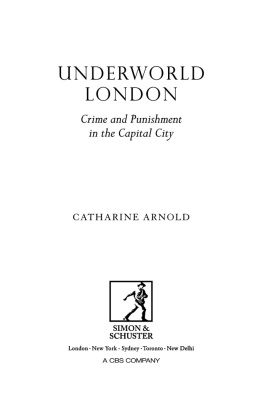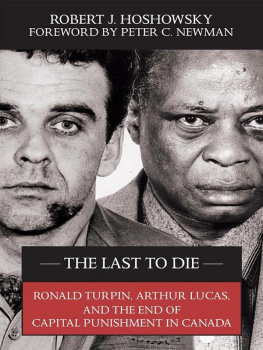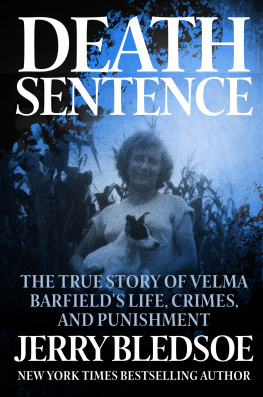
Among the many people who have helped me with this new extended edition of Hangmans Brae my grateful thanks are due to the following:
The staff of Aberdeen Central Library (Reference and Local Studies), who dealt with my numerous inquiries; Aberdeen and North-East Scotland Family History Society; Aberdeenshire Library Information Service, Oldmeldrum; Inverness Library (Reference Room); The Mitchell Library, Glasgow (General Services Department); National Library of Scotland (Reference Service); University of Aberdeen Historic Collections and librarians and archivists at Banchory, Banff, Forfar, Fraserburgh, Montrose, Nairn and Peterhead.
I am also indebted to Rachel Benvie, Curator, Montrose Museum; Dr David Bertie, Curator of Local History, Aberdeenshire Heritage; Helen Birnie and Sheila Jessiman, St Fergus; James A. Christie; Tina Craig, Deputy Head of the Royal College of Surgeons of Englands Library and Information Services, London; Judith Cripps, Aberdeen City Archivist; Chris Croly, Aberdeen City Council Assistant Keeper (Research), Archeological Unit; Fiona Watson, Archivist, NHS, Grampian; Fraserburgh Heritage Society; Graeme Wilson and Margaret Heron at Moray Councils Local Heritage Department, Elgin; and Calum Ross for copy-editing.
My special thanks go out to my son, Norman G. Adams, for his photography, Dr Joyce Miller, a leading authority on Scottish witchcraft, and to Sandy Strachan and Lys and Jim Wyness.
Credit must also go to Aberdeen City Council (Publicity and Promotions Department); Angus Council Cultural Services for providing the photograph of the Montrose branks; David H. Caldwell, Keeper Scotland and Europe, National Museums of Scotland, Edinburgh, for permission to reproduce the drawing of The Maiden; and Alex F. Young, a fellow chronicler of crime, for the use of William Calcrafts portrait.
CONTENTS
Carryin great loads the Shore up frae,
By Marischal Street and Hangmans Brae.
John Smith (1830)
A street map of Aberdeen is a guide to the dark side of the citys history for we can use it to walk in the footsteps of the hangman. Climb the Gallowgate and you follow the road to the gallows that stood on a high ridge outside the Gallowgate Port. In a gatehouse lodged the officer who was paid to whip offenders. He might even have acted as hangman.
The granite bow of Justice Street, in the north-east corner of the Castlegate, marks the beginning of a road that led to two execution sites. In the early Middle Ages stood the Justice or Thieves Port, the gate where they spiked the heads of felons and which led to Heiding or Heading Hill, where the kings justiciar held court in ancient times. Criminals were heidit either with a mighty sword or by means of The Maiden, a crude version of the guillotine. In the valley between Heading Hill and Castlehill they burned witches. The cleft between the hills is now Commerce Street.
In a later age, the Justice Port was also the start of the winding road to Gallow Hill, now part of Erroll Street and Trinity Cemetery, reached by way of present-day Park Street over the Thieves Brig. The gibbet on Gallowgatehill, the citys earliest known hanging site, was shifted to this lonely spot due to the growth of the town. Because of its proximity to Pittodrie Stadium, the breezy, grassy-topped eminence provided a free, if less than panoramic, view of the football ground and was known by older generations of Dons fans as Misers Hillie as folk could watch games without having to pay to get in. The Gallow Hill and The Gibbett are clearly identified on Parson James Gordon of Rothiemays plan of the burgh in 1661. In the next century culprits were hanged and their bodies suspended in iron frames on the gibbett until they were either stolen by anatomists or crumbled to dust. At nearby Footdee, pirates met their fate on hurriedly erected gibbets at the blockhouse.
Hangings occurred at the Ruthrieston crossroads and at Tillydrone, where the Old Aberdeen hangie officiated. A Jacobite spy, Daniel Campbell, was hanged by Redcoats from a tree at the Brig o Balgownie in 1746. A paper broadcasting his offence was pinned to his chest.
The theatre of punishment in Aberdeen in the eighteenth and nineteenth centuries was the Castlegate. The gallows occupied three sites. After a stubborn Alexander Morison, the last criminal to be gibbeted on Gallow Hill, failed to jouk the jibbet in 1776, executions were switched to the Market Place, the causeway opposite King Street. William Webster was the last felon to suffer at this spot. The gallows-stone, which had a socket for the upright post, was unearthed during excavations for the building of public toilets. A stone of the same description was dug up, and reburied, by workmen lifting the tram-lines in 1958. In June 1788 a new-style scaffold was built for the first execution at the door of the tolbooth, directly opposite to Marischal Street, giving rise to a grim jest that neer-do-wells would end their days facing doon Marischal Street. Kate Humphrey murdered her husband in 1830. Her husband had prophesised it would be her last view of the world, even if he did not live to see his prophecy fulfilled. Fenton Wyness, architect and noted local historian, arranged for a marker to be set in the cassies at the entrance to Lodge Walk but it vanished during road improvements. A sharp-eyed schoolboy reported its disappearance and it was restored. In the nineteenth century, the condemned walked out of a window in the old town house and on to the scaffold.
Wild Speyside moorland to the east of Elgin was the scene of two murders and a robbery. In an attempt to curb serious crime the culprits were hanged then exhibited in chains at the place where they committed the deed. Elgin, Forfar and Montrose followed the example of Aberdeen and other burghs by erecting a scaffold at the local tolbooth, which served as a jail and townhouse. The Aberdeen high tolbooth a prison tower, with eighty-six stairs and a steeple has survived and is now a museum. The laigh (low) tolbooth, which housed the courtroom and civic offices, was replaced with the present municipal buildings. A summerhouse at Duthie Park was built of stones from the laigh tolbooth. Visitors to it would lounge on benches salvaged from the burgh court as model yachts raced across the boating pond in front of them.
Stonehavens quayside tolbooth, originally a storehouse, became a prison and courthouse in 1600. The towns oldest building now has a museum downstairs and a restaurant above.
Youll find no trace of Hangmans Brae on an Aberdeen street map, nor the fragrant mignonette, which once flowered there. Hangmans Brae was the colloquial term for a steep, narrow, walled path, paved with blue-hued stones, which began in the south-east corner of the Castlegate before plunging towards Virginia Street. The steps opposite to present-day James Street are roughly on a line with the brae, which was originally Futtie Wynd and later known as Castle Brae. The public hangman, the notorious Johnny Milne, lived in the vicinity. The brae led to his home, dubbed Hangmans Hoose, on the east bank of the old canal, which was crossed by Hangmans Brig, replaced by the Tarrie Brig. The steep hill, a popular, if dangerous, playground during Victorian winters, vanished in 1857 when it was absorbed by a new road, Castle Terrace. A sketch shows Hangmans Brae before its demise. A sign, depicting a matchstick figure on a gibbet, may have advertised a tavern.
Aberdeens gruesome past continues to fascinate people of all ages. In August 2004 the staff of a city bookshop organised a charity Murder Walk for its customers and over the Christmas period the city council promoted the darker side of the Castlegates past, with guided tours of the tolbooth. Johnny Milne even made an appearance. The tour ended with a glass of mulled wine in a nearby hostelry which was appropriate for, after nineteenth-century executions, councillors adjourned to the nearby Lemon Tree for a dram to soothe their nerves.
Next page
